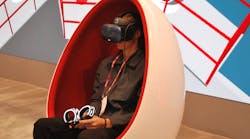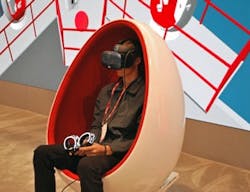This Automation Fair attendee is immersed in a running 3D model of a soda production and packaging line. His avatar can interact with the simulated processes as well as other attendees’ avatars.
Once "virtual" and "reality" got together, it was only a matter of time before their models and digital twins began to make changes in the real world—and do it faster and easier, too. One of the chief innovations in this VR-fueled realm follows Rockwell Automation's acquisition of Emulate3D this past January, along with its dynamic simulation software environment that recreates physical systems, and allows users to perform virtual testing and commissioning.
"Users can take 3D CAD renderings of machines or equipment, and mark them up with functions like sensors and motors, and connect to their tags in the controller that's managing them. This allows the model of a production line to be automated, just as if it was a real, physical system," said John Pritchard, global portfolio management team, Rockwell Automation.
"For instance, a Logix controller that might normally control our iTrak intelligent track system can work with this simulation software, and give and receive the outputs and inputs it usually expects with physical equipment, but now interacts in the same way with a digital model. In short, the controller connects to and runs the model of the machine. This has powerful implications because it can change how our customers work."
Pritchard highlighted these groundbreaking advances in virtual commissioning during a tour of Rockwell Automation's Innovations exhibit this week at Automation Fair 2019 in Chicago.
Cut-and-reuse functions
Of course, once this virtual-physical link is established, the virtual model and physical controller can use the 3D software to extend their relationship. Users can access a growing catalog of predefined software objects, such as iTrak controller, iTrak straight section, iTrak curve section, iTrak 50-mm mover and others—and do it without having to write or program any code.
"Users can quickly and easily 'snap together' these software devices in the model to create functional designs, and give them speed, position, move and other commands," explained Pritchard. "They can run their design in the model, interact with it, determine if they need more carriages, or if they're running too many, play around with the system, and see what combination works best. This can all be done without assembling and testing physical devices, which can save huge amounts of time and money."
Downloading to control
Once virtual testing and commissioning is completed, Pritchard added, there's even more good news.
"After the experiments are done, the optimal system is designed and tested, and when programming needs to be added to the real-world controls, users can apply scripting and our Application Code Manager library to 'automagically' generate from the model all the control code for each physical mover in the iTrak system, and download it to the physical Logix controller," added Pritchard. "They can also add I/O, conveyors and other devices as needed.
"This is true virtual commissioning, sequencing, collision avoidance, and continuous and flexible independent-cart technology. However, it's happening in a digital design environment that allows model-based code generation, out-of-the-box collision avoidance and PLC code generation."
Prichard added that Rockwell Automation is also working with FANUC and its RoboGuide software that teaches fixed-arm and other robots how to move and sequence actions. "RoboGuide can connect to our 3D software, so users can drop its functions into our models for a virtual manufacturing environment," he said. "This is the same digital twin capability we're doing with iTrak, but now we can add robots and potentially many other types of equipment."
Step into the screen
Finally, and most astonishingly, for designers and other users that want to move their design and commissioning process beyond the usual flat-screen, Prichard reported that the 3D modeling and commissioning software has a virtual reality (VR) button that can deliver its models to a VR headset—allowing a user to "walk around in" and interact with the models they've created.
"This is what's really groundbreaking about our 3D software. It can literally change the life of design engineers by bringing together design, commissioning and control functions that used to be disconnected," concluded Pritchard. "Rockwell Automation has always maintained a reputation of taming complex technologies and making them easy to use, and this is a shining example of it."
Pritchard added this immersive-experience feature also allows multiple users to enter, inhabit and interact within a single model. "Once users put on a VR headset, they're represented in the model by digital avatars," said Prichard. "They can communicate with other users and their avatars by gazing, nodding and shaking their heads, and by pointing and waving."
The editors of Control are on-site at Automation Fair 2019 to bring you breaking news, innovations and insights from the event. Once the event is over, they will put together a report featuring the top news. Pre-order your copy today.







